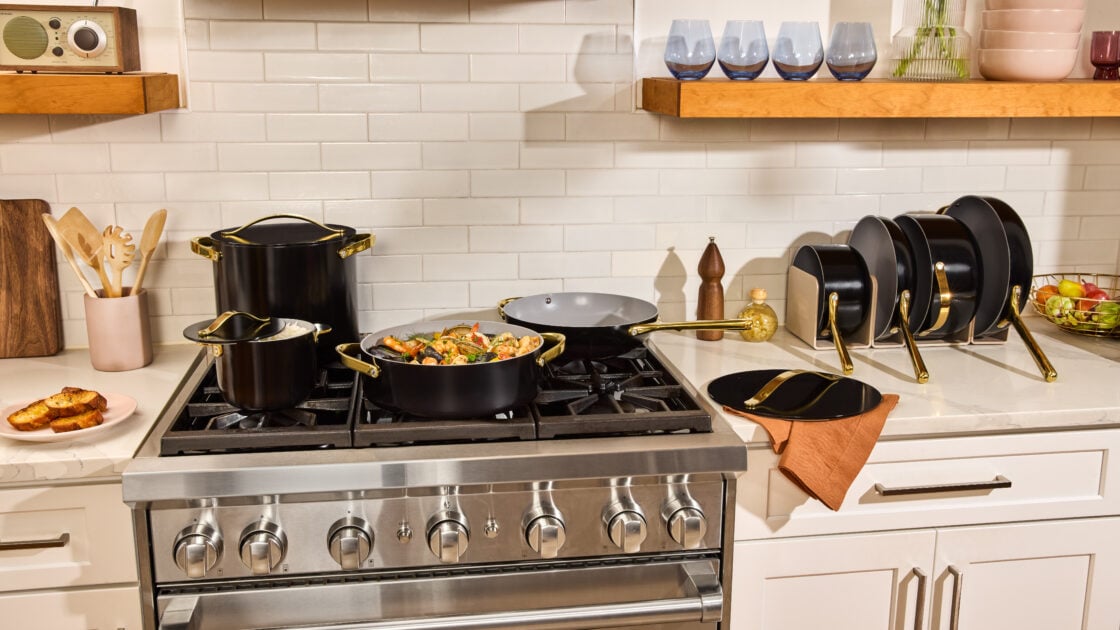
When it comes to cookware, consumers are demanding transparency and safety—and finally, companies are listening. It’s why I’ve been testing non-toxic cookware and am doing this Caraway cookware review.
However, the increased demand also means that many brands are flirting with falsehoods, and some are even making outright false claims about how “green” and clean their products are. Instead of making their products cleaner, manufacturers use misleading labels to make you think you’re using your purchasing power to do good.
Enter Caraway. A brand that has captured the hearts (and kitchens) of health-conscious consumers with its oh-so-pretty, non-toxic cookware—they’re doing it right.
Ok, sure, pretty is one thing, and non-toxic is quite another. But, as a chef who’s been testing cookware for over 10 years (yes, really), I also care about the performance (how’s the nonstick?), functionality (can I sear veg or protein?), and longevity (is the investment worth it?).
“Finally, a company that cares about the quality of non-toxic, non-stick cookware.”
Laura Klein, Chef & Wellness Expert
One of the biggest draws of Caraway cookware is its commitment to using safe, non-toxic materials. Unlike traditional nonstick pans that may contain PFAS chemicals like PTFE, PFOS or GenX and lead (which are linked to human health and environmental issues), Caraway’s Sol-Gel ceramic coating is free from these forever chemicals. This gives you peace of mind knowing you’re not leaching nasty toxins into your food.
I’ve cooked everything from delicate eggs, fish, pasta, sauces, nachos, soup, enchiladas, pancakes and more in my Caraway pots and pans, all with minimal sticking. And I’m still using my five- year-old set. That’s a big deal. Most ceramic coated non-stick cookware doesn’t even touch that longevity. Keep reading and you’ll uncover why my pots and pans have lasted this long
In this review, I’ll break down the science behind Caraway Cookware’s ceramic coating, share my experience using the cookware, and help you decide if it’s the right choice for your kitchen.
Want more top picks? Sign up for the newsletter for more well-researched, non-toxic living guidance and smart wellness advice.
Labor Day Sale Alert!
Save 30% on the Meal Prep Bundle
Use Code: backtoschool24 Sale Ends: Sept. 1st
Shop Now
Save 15% on the Back to School Prep Bundle
(No code needed) Sale Ends: Sept. 3rd
Shop Now
Save 10% of the Back to School Prep Bundle
(No code needed) Sale Ends: Sept 3rd
Shop Now
My Experience Testing Cookware
I’ve been testing and cooking with Caraway, for over five years now (I seriously love my job!). I’ve tested everything from their Classic Cookware Set, the Iconics Cookware Set, to their Bakeware and even their Food Storage Set. (And peep my Caraway gift guide here.)
I remember the first time I opened my first Caraway cookware set in Perracotta and felt it in my hands. I vividly remember saying to myself, “Finally, a company that cares about the quality of non-toxic, non-stick cookware.”
I’ve been testing non-toxic cookware, clean bakeware and ceramic cookware for over ten years, and up until that point, very few impressed me. Most were too light and flimsy, which led to hot spots, and burned up food. This also quickly deteriorated the non-stick coating, leaving most non-toxic, nonstick cookware useless in as little as three months.
Caraway is different. As a culinary school grad, I knew the difference between well made, quality cookware, and the cheap stuff that burns up easily and ends up in the trash.
In the hand, Caraway feels solid and well made. It has some weight to it, so I know it won’t burn up food with hot spots. I couldn’t wait to give it a test run. But is it safe? First lets cover why traditional non-stick, PFAS cookware isn’t safe for anyone.
Have a question about Caraway or non-toxic cookware in general? Ask me in the comments and I’ll personally respond to you!
Here’s What’s Wrong with Traditional Non-Stick Cookware
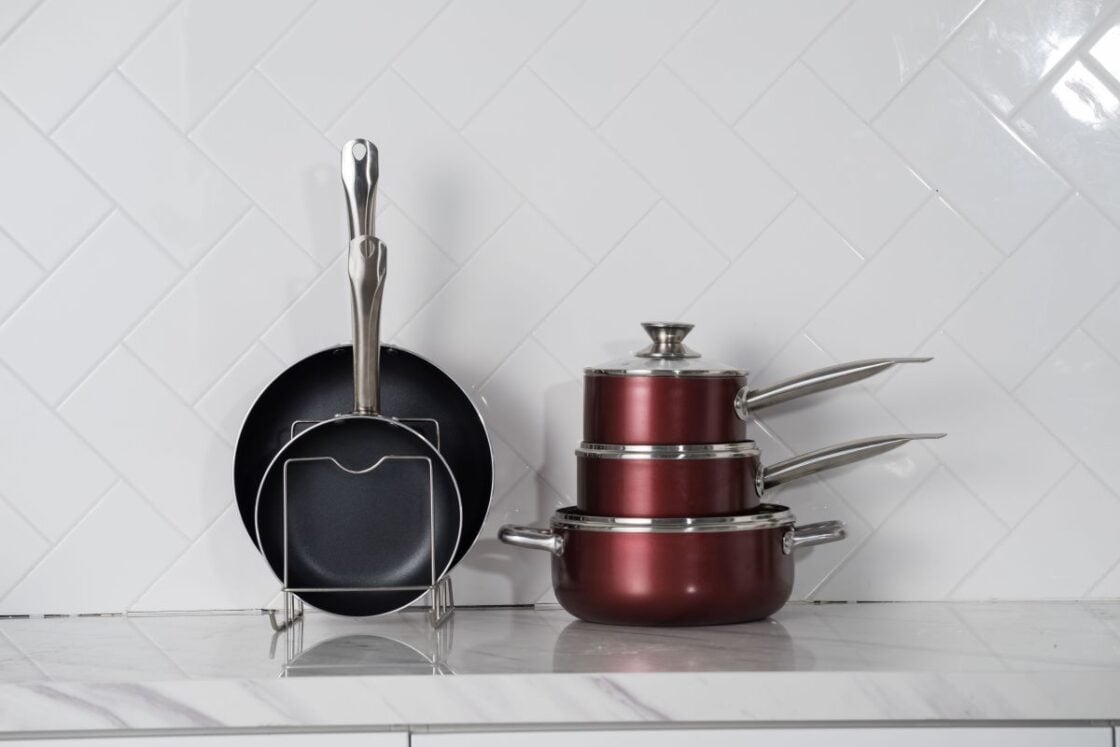
Traditional nonstick cookware is made with a plastic coating of PFAS chemicals, now colloquially known today as, ‘forever chemicals’ (read our coverage: Forever Chemicals: Everything You Need to Know).
Most are commonly made with PTFE and GenX (aka high-performance fluoropolymers without the use of perfluorooctanoic acid (PFOA) — think the new Teflon), which is linked to a multitude of health concerns like testicular and kidney cancer, infertility, liver damage, and thyroid disease. 1,2 Now you know why we need safer non-stick alternatives (you can read more about it in, PFAS in Pesticides: How We’re Exposed to Cancer Causing Chemicals). I don’t think a “perfect” PTFE nonstick surface is worth that.
Polymer Fume Fever
Oh, and BTW, if a plastic PFAS nonstick coating is heated to over 500 degrees Fahrenheit, that can cause it to break down and release toxic fumes which can lead to a human condition called polymer fume fever. And if that isn’t enough, research shows that one crack can release millions of microscopic particles into your food. That’s seriously awful.
Non-Toxic Cookware Defined
Many people like the idea of ‘non-toxic’ cookware, but what does it really mean? Our definition of clean cookware is any cookware that does not contain a nonstick coating made with PFAS chemicals, lead or cadmium. Some people have additional concerns that go beyond this when it comes to additional metals, if this is you, we recommend you seek advice from your personal physician.
Is Caraway Non-Toxic? Here’s What It’s Made of
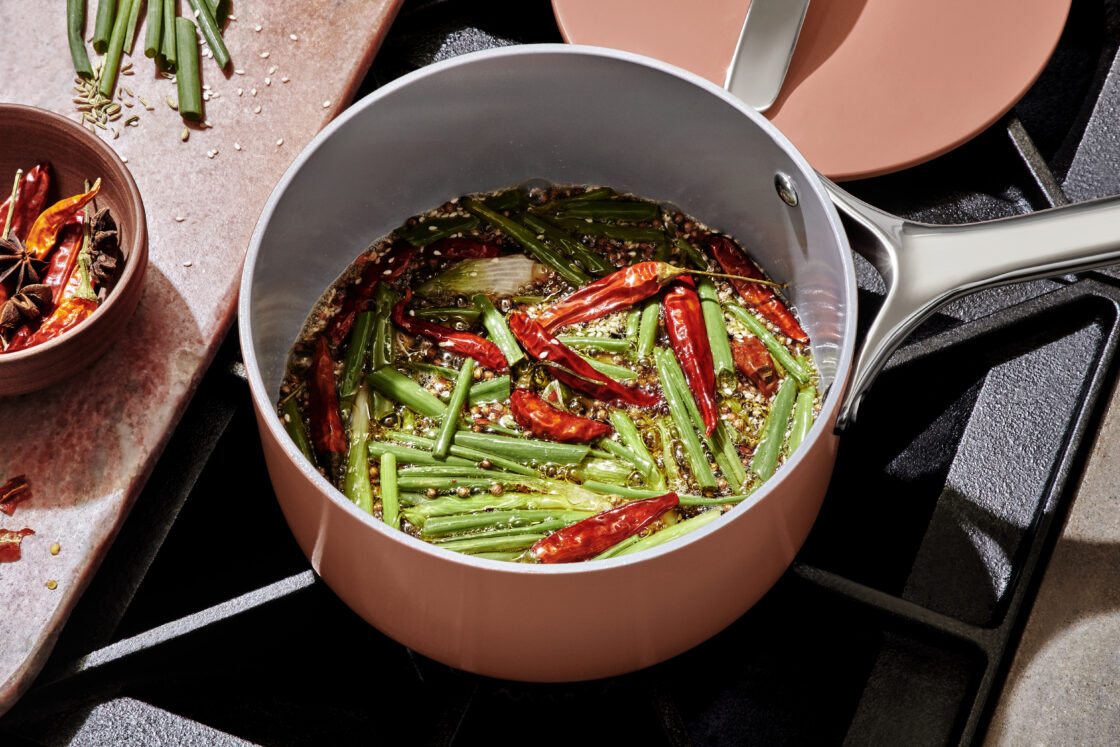
The Body
The body of the pan is composed of an aluminum core, which is ideal for heat conduction (and, no, your food won’t come in contact with it, unless you seriously damage it and put a big dent in it), with a ceramic exterior and a non-stick ceramic coated interior. The bottom has an induction compatible stainless steel base which is also excellent for durability.
The Lids
The opaque lids are made with a cast aluminum core with a ceramic exterior and nonstick interior.
The glass lids are made with clear tempered glass and are oven safe up to 425 degrees Fahrenheit. The glass lids are a little more temperamental though, to avoid thermal shock, allow them to cool before running them under cold water. The plus side is that these can go in the dishwasher.
The Handles
And the handles are cast and polished stainless steel which come in two colors! Silver or gold hued for an elevated look.
Labor Day Sale Alert!
Save 30% on the Meal Prep Bundle
Use Code: backtoschool24 Sale Ends: Sept. 1st
Shop Now
Save 15% on the Back to School Prep Bundle
(No code needed) Sale Ends: Sept. 3rd
Shop Now
Save 10% of the Back to School Prep Bundle
(No code needed) Sale Ends: Sept 3rd
Shop Now
The Ceramic Coating Technology
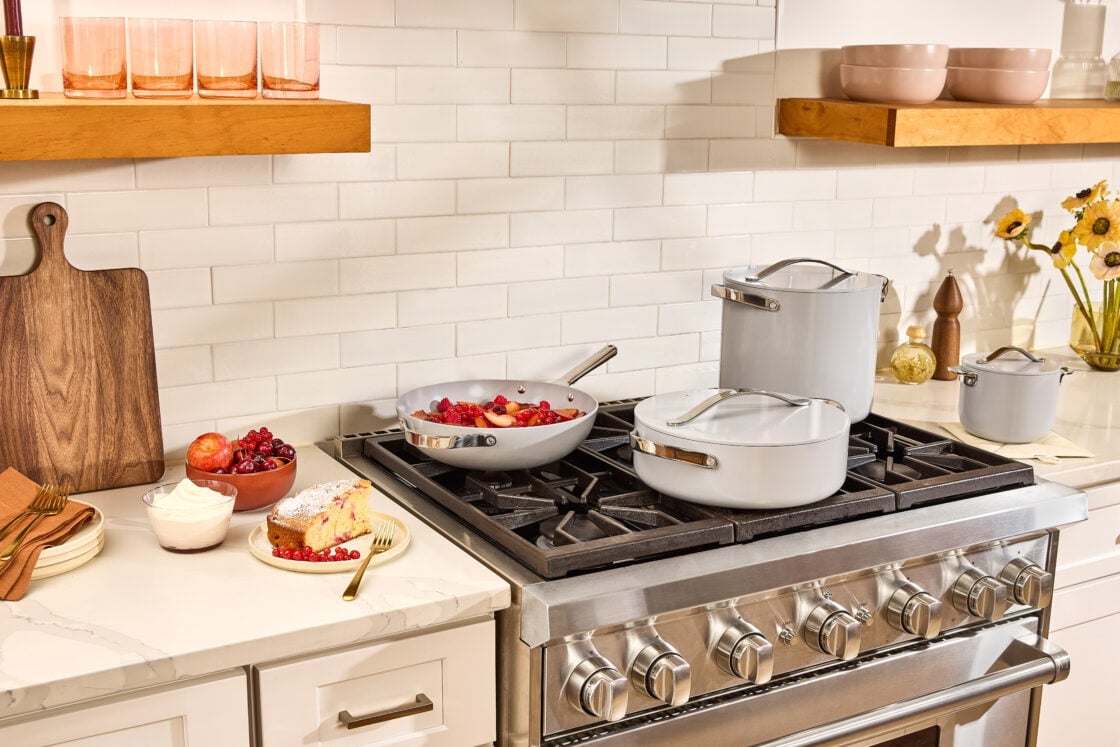
Unlike traditional nonstick cookware, Caraway employs a ceramic coating derived from silica. This ceramic coating is free from harmful PFAS chemicals, lead, and cadmium. It provides a stable cooking surface (it won’t off-gas toxic fumes at high temperatures), making it a safer choice for everyday cooking.
The coating composition is proprietary. I’ve seen documentation that it meets and complies with statutes and limitations set by the FDA, EU and other regulatory agencies.
How the Ceramic Non-Stick Coating is Applied
Caraway’s ceramic coating is applied using a sol-gel process. This method involves creating a suspension of microscopic silica particles in a liquid medium. This mixture is then applied to the cookware and undergoes a curing process to form a hard, non-stick surface. This process is considered more environmentally friendly than traditional methods due to lower emissions and reduced chemical waste.
Third-Party Testing
Caraway does third party testing. All testing is done in globally accredited laboratories that follow governing bodies strict compliance regulations and requirements. They’re also California Prop 65 certified and have earned the Organic Authority Approved Seal (you can learn more about our standards here).
Caraway’s Manufacturing Practises
Caraway is also committed to ethical and responsible manufacturing practices. The cookware is produced in world-class factories based in China that meet Caraway’s strict standards and adhere to BSCI or SMETA guidelines. These certifications ensure responsible labor practices and safe working environments.
This commitment extends beyond just following regulations. Caraway prioritizes building strong relationships with their suppliers and fostering a shared sense of responsibility. They believe in transparency throughout the manufacturing process, giving you peace of mind about the origin of your cookware.
So, Is Caraway Worth It? My Tests and Review / Here’s What I’ve Cooked / Caraway Cookware Tested /
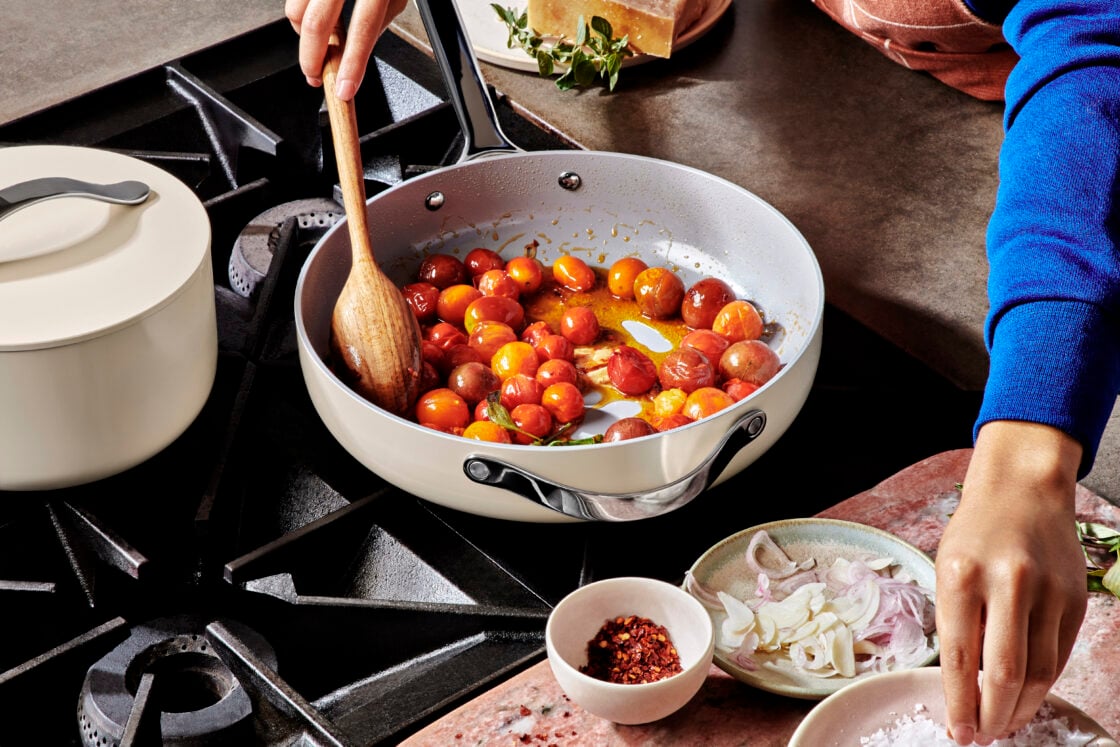
Ok now you have the deep dive into the brand, now it’s time to dive into why we’re here: Is Caraway worth it?
Design Loves
There are a few things I love about these pots and pans. First they have an aluminum core which is excellent for heat conduction. Then the pan is then wrapped in ceramic with a stainless steel base.
All of this translates into even heat conduction and a pan that heats more efficiently which is why the brand recommends low to medium heat when cooking, and I agree. The pans do take a little longer to heat up, but once heated they retain heat well, so you don’t need super high temperatures anyway.
The Saute + Fry Pans
Caraway pans have higher walls, which may or may not be important to you. They are nice because they help prevent splatters and spills. However, they can be limiting when it comes to flipping food and sliding it out of the pan.
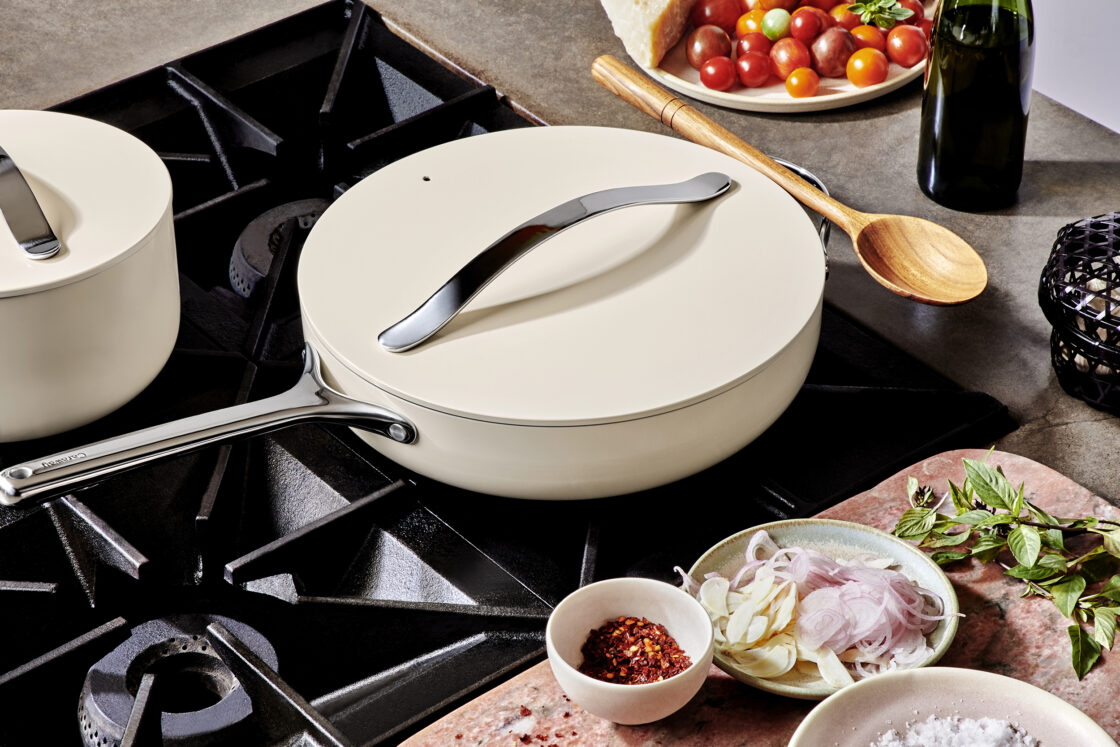
The 4.5 quart saute pan is a large oversize pan. You can cook larger volumes of food because of the high walls. So it’s ideal for dinner parties and large family gatherings. You do have to be careful about stacking your food in a pan like this. Overstacking food creates steam and limits your ability to brown food adding an extra layer of flavor and texture.
I love, love, love the helper handle on this pan. When the pan is full—it’s heavy. The helper handle allows you to easily pick up the pan with two hands and move it around the kitchen. Use pot holders if the pan is hot, as the handles can get hot!
The 6.5 qt Dutch Oven
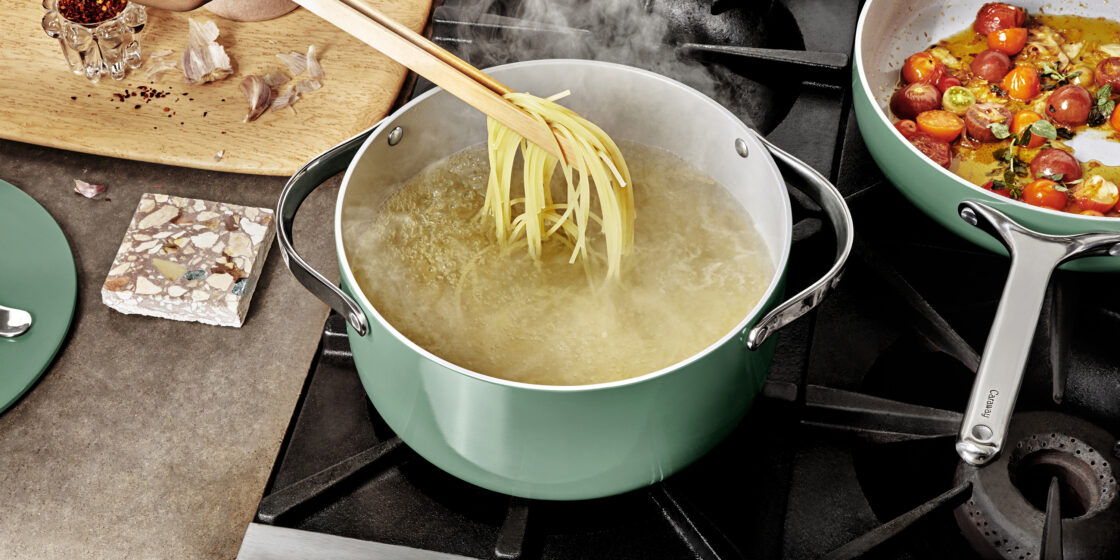
One of the stand out features when you buy a cookware set from Caraway, is that it comes with a Dutch oven (most cookware sets don’t!). It’s a nice size that’s ideal for pasta night and slow cooking your next pot of chili, or butternut squash soup.
The Storage System + Lids
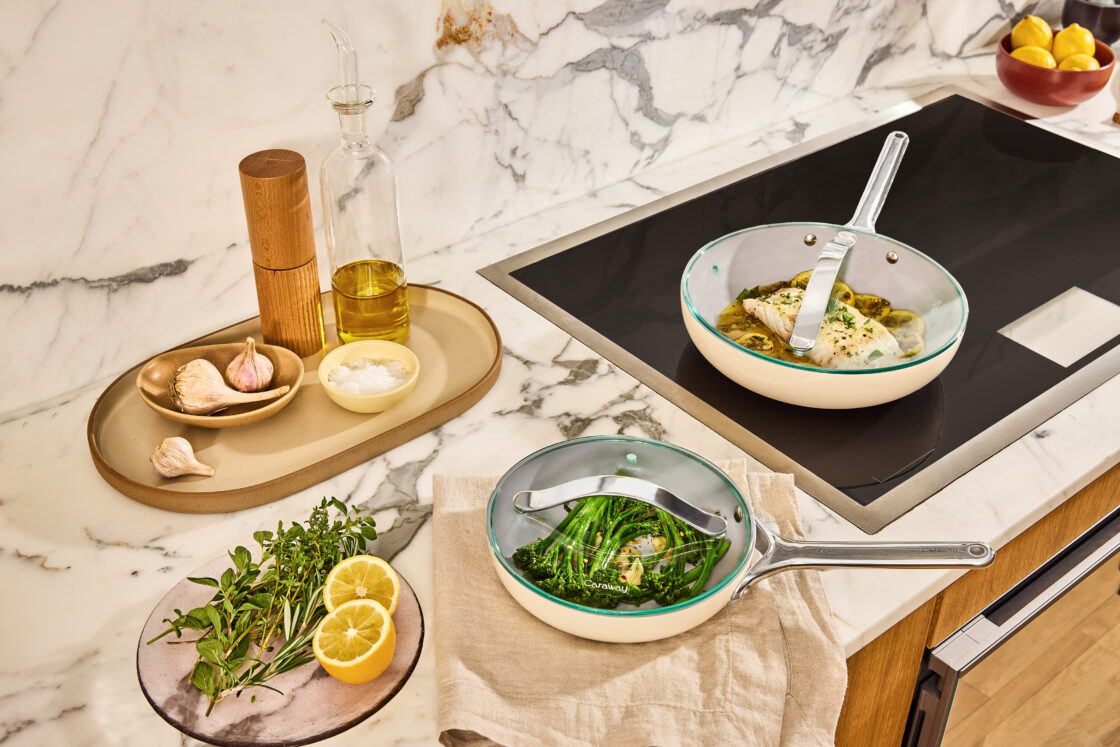
When you buy a set, it comes with their famous storage system, which may or may not be important to you. You can either put these on your countertop or put them in a cupboard out of sight.
And the lids come with their own canvas holder that you can attach to a wall inside a pantry or a cabinet door. So you never have to search for lost lids again. Another nice feature about the lids are the steam vent. If you cook oatmeal like me on the regular, the steam vent helps prevent boiled over messes. And if you want to see what you’re cooking, you can now order glass lids. If you ask me, they’re pretty slick looking.
Finding the Right Set for You
You can buy these pots and pans in an array of colors and even stainless steel. You have many purchasing options including singles (a great way to test them), minis, or choose from multiple collections which have some nice value added additions.
The Classic Cookware Set

This classic 4-piece set includes:
- 10.5” Fry Pan
- 3 qt Sauce Pan
- 4.5 qt Saute Pan (with helper handle!)
- 6.5 qt Dutch Oven
- 3 opaque lids (w/ steam vents!)
- Pan Storage
- Lid Storage
$395 – At time of publish
The Cookware+ Set

Caraway’s newest option, according to Caraway’s website, is this 8-piece set, with four pans in new shapes and sizes. It includes:
- 2 qt Petite Cooker
- 6 qt Rondeau
- 12 qt Stock Pot
- 12” Stir Fry Pan (with a helper handle!)
- 3 opaque lids (w/ steam vents!)
- Storage
$495 – At time of publish
Cookware & Minis Set
Caraway introduced mini pans a few years ago, and they became so popular that they bundled them into the Classic Cookware collection so people could get an additional value when they purchased them together.

This is a 6-piece set and includes:
- Lid Storage
- 10.5” Fry Pan
- 3 qt Sauce Pan
- 4.5 qt Saute Pan (with a helper handle!)
- 6.5 qt Dutch Oven
- 8” Mini Fry Pan (this pan could be your designated egg pan!)
- 1.75 qt Mini Sauce Pan
- 4 Opaque lids (with steam vents!)
- Pan Storage
$595 – At time of publish
The Stainless Steel Set
For you high heat cookers (I’m one of those!), the five-ply Stainless Steel Cookware Set is stunning. With its monochromatic tone of stainless steel interior, exterior, lids and handles, they’ll look just as stunning on your stove as a color way. This set comes with a lifetime warranty.

A set includes:
- Lid Storage
- 10” Fry Pan
- 3 qt Sauce Pan
- 4.5 qt Saute Pan
- 6.5 qt Dutch Oven
- Pan Storage
$695 at time of publish
My Trick to Longevity with Nonstick Cookware / How to Get the Most out of Your Cookware
I follow the rules. Here they are.
Cook Over Medium to Low Heat
I use ceramic nonstick cookware strictly for medium to medium low cooking and for delicate items like eggs and fish. I don’t do any high heat searing in them. I leave that for my stainless steel, cast iron, or carbon steel.
Don’t Use Metal Utensils
I don’t use metal utensils, I only use wood, bamboo or silicone. Metal utensils will scratch and quickly degrade the non-stick surface, rendering it useless.
Hand Wash Only
I also don’t put them in the hot dishwasher. I always wash them by hand. Remember scalding temperatures will quickly render the non-stick surface useless too. A quick swipe with a sponge is usually all it takes to clean them, making post-meal cleanup quick and easy. Shockingly when I burned the cheese on my nachos with the bakeware set, it easily came off with a soft brush, warm water and soap.
No Cooking Sprays
Cooking sprays will ruin the nonstick surface in fact many cookware companies will void their warranty if you use them. Need I say more? To learn why nonstick sprays are bad for cookware, read this.
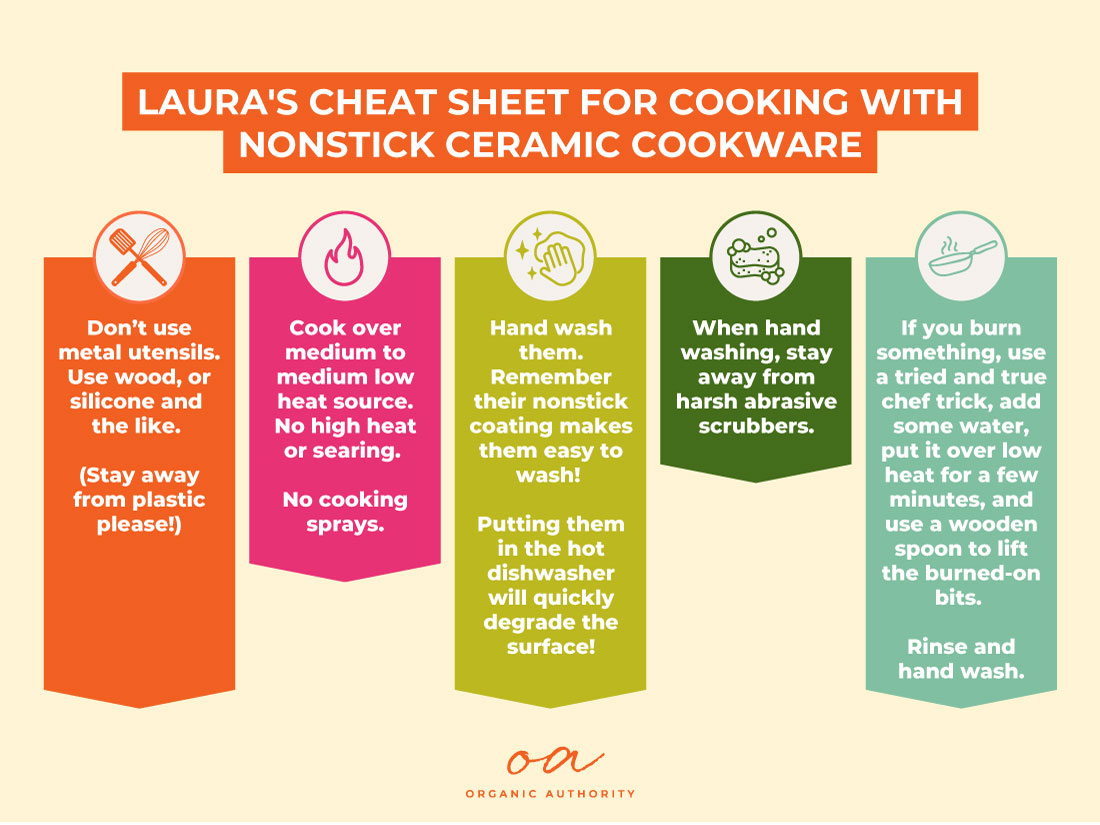
Addressing Common Complaints
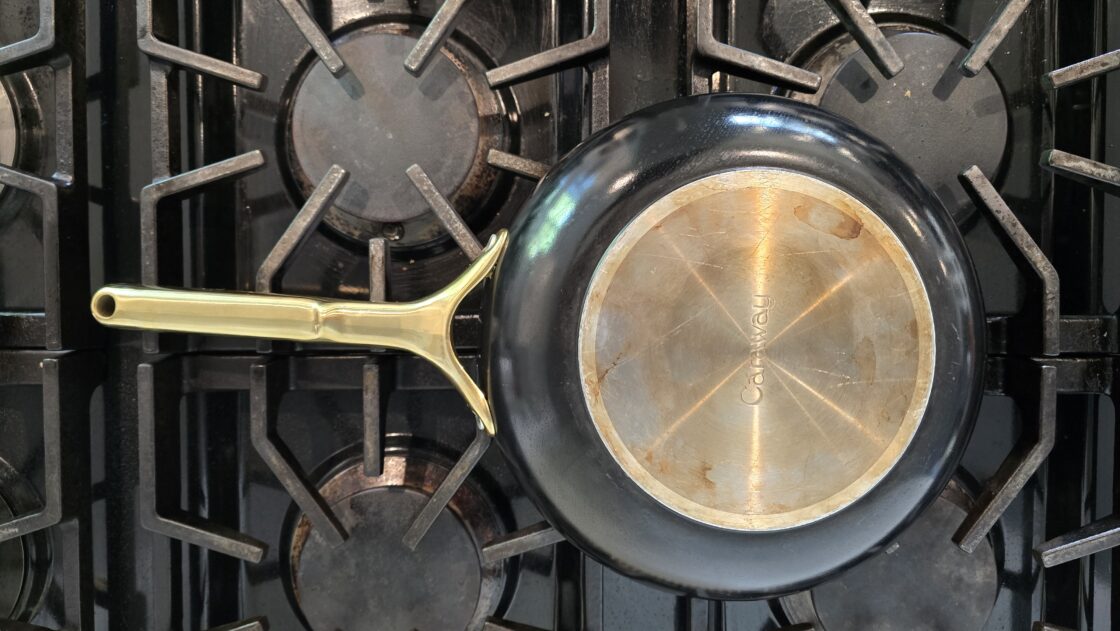
Here are some common complaints along with my experiences and thoughts:
- Paint Chipping: Have I experienced it? No. I cook on a gas stove with cast iron grates. But I’m really careful about the use of my cookware. I don’t use metal utensils and I don’t bang them around.
- Stains: I have not experienced stains with two sets. You may experience some discoloration on the bottom of the pans with use, but that’s normal wear and tear with any cookware set.
- Losing its non-stick surface – over time, all nonstick surfaces lose their slickness – even PTFE or Teflon. It’s just the nature of the material. If treated properly and you follow my guidelines (and the manufacturer’s you can get three to five years out of your nonstick cookware!)
- Can’t cook over high heat: This is true and we’ve covered this. This is where your stainless steel, cast iron or carbon steel pans come into play. In my opinion you need more than one type of cookware material in your kitchen.
- Can’t use metal utensils: True and we’ve covered why above.
The fact is, when using any non-toxic, nonstick cookware, you will need to make adjustments to your cooking routine to prolong its life. If you love to cook everything over high heat, use metal utensils, harsh scrubbing pads, or don’t want to wash by hand, then this non toxic, nonstick cookware is probably not for you.
The Pros and Cons of Caraway Cookware
We love to do the work of wading through claims and testing cookware, but sometimes you just want a simple list of pros and cons. Here’s a quick breakdown.
| Pros | Cons |
| Non-Toxic: Free from harmful PFAS, or ‘forever chemicals | They don’t last forever |
| Sol Gel Non-Stick Coating | Higher price point |
| Even heat distribution | The handles heat up (they have a notch to let you know when you’re getting close to the danger zone) |
| Easy to clean | Not metal utensil resistant |
| Stylish design | Hand washing required |
| Storage solutions | |
| Durable (for non-toxic, nonstick) | |
| No off-gassing risk |
More Common Questions Answered
Stovetop Compatibility
Caraway cookware is engineered to be used on all cooking surfaces, including gas, electric and induction. However on the website they note that, “Although our cookware is compatible with induction stovetops, not all induction stovetops are compatible with us! We suggest reaching out to your manufacturer to confirm.”
Is it Oven-Safe?
It is! Caraway’s pots and pans can handle up to 550°F without breaking a sweat. This is seriously exciting considering traditional PTFE, Teflon pans start off-gassing noxious fumes at around the same temperature!
Do I Need to Use Oil?
Yes, Caraway recommends that you use a little of your favorite healthy oil or fat like ghee to maximize its slickness and help keep things moving in the pan.
The Clean Up
Yes, handwashing is required but is so easy! Easier than stainless steel, carbon steel, and cast iron.
Longevity
While generally very durable for non-toxic nonstick cookware, eventually they will need to be replaced, unlike some options that may last a lifetime like stainless steel or cast iron.
When it comes to nonstick, the fact is no matter which brand you use or how careful you are with them, they won’t last forever. But, that being said, if you take a little extra care, they can last for years (I have the proof in my kitchen!). My first Caraway cookware set is five years old and I’m still using it!
Organic Authority Approved Clean Cookware

Because of Caraway’s transparency, thoughtful design, and utility, the brand has earned Organic Authority’s Clean Cookware seal of approval. If you want to know more about what that means, read, The Organic Authority Approved Manifesto.Still don’t know which set of pots and pans are right for you? Take our Cookware Quiz to get more personalized recommendations.
Sources:
- https://www.ewg.org/tapwater/contaminant.php?contamcode=E207
- https://www.cancercenter.com/community/blog/2021/09/does-teflon-cause-cancer
- https://www.epa.gov/chemical-research/human-health-toxicity-assessments-genx-chemicals
Source link
